Study of Japanese University Students' Perceptions of Teachers
Chapter Two: Teaching as a Profession
- Introduction
- Chapter 1. Goals of Research / Survey
- Chapter 2. Teaching as a Profession (This paper)
- Chapter 3. Perception of Self and Future Prospects in Education
- Chapter 4. Thoughts About Teachers' Pedagogies
- Conclusion
- Glossary
| b. Elementary Schools: Teachers Who Are Closely Involved with Pupils At the elementary school level, the categories "teachers who carefully listened to what children had to say" (29.3%), and "teachers who had a sense of humor" (25.9%) tended to receive high approval. Likewise, "teachers who reprimanded bad behavior" (13.8%) and "teachers who participated in recreation during recess period and after dismissal" (10.3%) also showed this tendency, indicating that they liked those teachers who were closely involved with pupils. c. Junior High Schools: Teachers Who Are Able to Manage Adolescent Pupils At the junior high school level, the highest percent of responses indicate: "teachers who carefully listened to what children had to say" (20.0 %); "teachers who valued children's independence" (13.3 %), "teachers who had a sense of humor" (12.4 %), and "teachers who were good role models" (11.4 %) received approval from students. Those teachers who could respond well to adolescent students trying to break from childhood into adulthood were rated favorably. d. High Schools: Teachers Who Offer Career Guidance At the high school level we see that teachers with good leadership ability in their field, that is, "teachers who had extensive knowledge" (22.4%) and "teachers who taught so as to make lessons comprehensible" (12.1%) were considered desirable. This outcome may have been a result of the fact that because the target of our survey was students at a national university, of whom most were very conscious of entrance examinations. At the same time there were many voices of approval for "teachers who were good role models" (15.5%) and teachers who were helpful in career guidance and life goals. |
| 2. Desirable Teachers As noted above, university students majoring in education think differently about the characteristics of a "great" teacher depending on grade level. This fact shows that the image of a desirable teacher changes in accordance with the level of student advancement. Next let us consider how these students think about what kind of teacher is appropriate at each level. We had respondents answer as directly as possible to each question on the survey form, asking them to choose between two possibilities, "If you had to make the choice, which of the two is better?" We inquired about the following five categories for each level: (1) the teacher's sex (male or female), (2) experience (beginner, veteran), (3) type of teaching (teaching subjects, teaching life skills), (4) personality (methodical, magnanimous), (5) attitude towards other people (kind, strict). The following clarifies university students' perceptions on what kind of teacher is most appropriate at each level. a. Sex First, we asked the students what sex of teacher is most appropriate to each grade level if they "had to make the choice." As opposed to the elementary school level, with over 60% approval of female teachers, 70 - 80 % approved of male teachers for the junior high and high school levels. The students thought that a "female" quality was essential for an educator's duties at the elementary level, and conversely a "male" quality was essential in junior high and high schools. 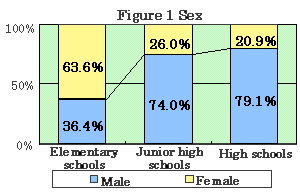 b. Experience Next we asked students to choose between "beginner teachers" and "veteran teachers" at each of the levels. In the elementary schools, where teachers are in close contact with children, novice teachers received approval. However once pupils advanced to junior high and high school, veteran teachers gathered more support. In the junior high and high schools, naturally the teaching of subjects was given, and because it was closely connected with pupils' career determination, veteran teachers with more life experience received more approval. 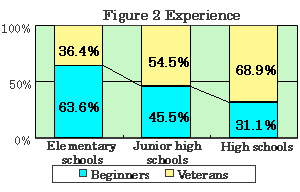 c. Type of Instruction Teachers have many duties, but the instruction they give to pupils is among the most important. Instruction can be broadly divided into two types. The first is teaching of subjects, which is focused around classes; the other is life skill instruction, which involves pupils' whole lives. The importance of these two institutions seems to vary according to grade level. Figure 3 shows that in the elementary schools, the role of the teacher is thought to be more related to life skill instruction than the teaching of subjects. At the junior high school level, emphasis on instruction in disciplinary subjects and in life skills is at about 50 per cent each. At the high school level, we find that the teaching of subjects is emphasized over life skill instruction. This indicates that, for the students, high schools are where one is most conscious of entrance examinations. 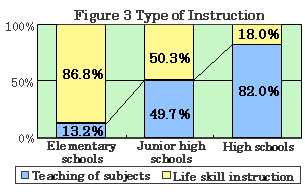 d. Personality Teachers are of all kinds of personality types. It is impossible to grade personality, but these students aspiring to become educators were asked to choose between "methodical" and "magnanimous" teachers at each level. As far as can be seen in Figure 4, "magnanimous" teachers received a higher approval rating at every level. This was a trend particularly at the elementary school level, where over 90% of the answers favored "magnanimous" teachers, reflecting students' perceptions of teachers. 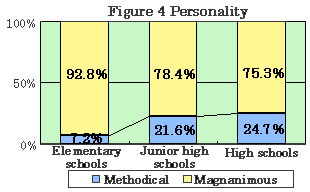 e. Attitude Towards Other People Just as we spoke of "methodical" and "magnanimous" teachers, there are also teachers who are "kind" and "strict". There are, of course, pros and cons to each teaching style. So, when we asked the university students majoring in education if they "had to choose," which kind of teacher they felt was more likeable, as we see from Figure 5, the majority responded in approval of "kind" teachers rather than "strict" teachers. The proportion was particularly high at the elementary school level, reflecting students' perceptions that a maternal style of teaching was essential. They believed this type of teaching method was thought especially appropriate to the developmental stage of children at a very young age. For the junior high and high school levels, there were a certain number of those who approved of strict teachers (47.1% for junior high schools, 35.8% for high schools). Thus, the desirable teacher differed depending on schooling level. 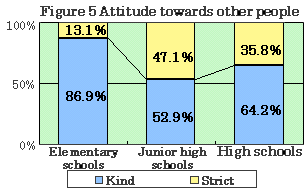 |
| 3. Summary Above is an explanation of university students majoring in education' perceptions of "teachers as professionals". The major points are summarized below. University students in education favor a teaching style that stimulates children's growth instead of a repressive "management" style. Rather than simply teaching lessons, the students felt that nurturing children was the duty of elementary school teachers. In the case of junior high school educators -- who instruct students who are experiencing extreme changes in mental and physical development and who also face complex situations -- the university students majoring in education felt that, regardless of sex, a desirable teacher was one who could accurately grasp and respond to the situations that their pupils were confronting. University students majoring in education believed high school was where career guidance was critical, and it was clear that they felt that it was a place where strength in the teaching of subjects is desirable. Therefore, for university students majoring in education, the teaching profession is one where instruction takes place in accordance with the developmental level of the targets of instruction at each grade level. They had a clear awareness of the differences in the conceptualization of the ideal teacher at each level, and this sheds light on the special characteristics of teaching as a profession. The above discusses the point of view of university students' perceptions of the teaching profession. Furthermore, juxtaposing their image of "former teachers that they considered likable" and that of teachers they would consider competent in general, they have consciously and unconsciously internalized their experience of their own teachers over the course of their schooling, and we can suppose that this has become the basis of their ideal image of a teacher. Moreover, it is likely that both are related, and this is very interesting. We have not examined this in this chapter, but we believe it would be a good topic for future study. |














